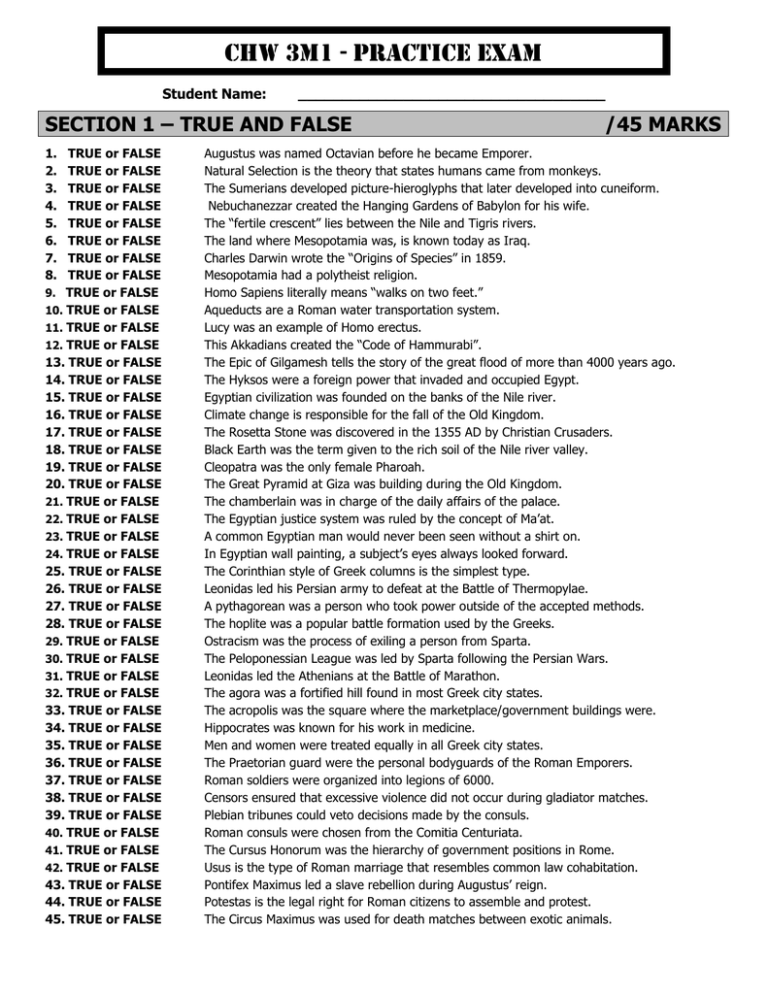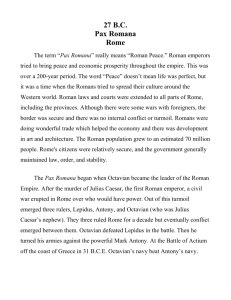SECTION 1 – TRUE AND FALSE ... Student Name: ___________________________________
advertisement

CHW 3M1 - Practice exam Student Name: ___________________________________ SECTION 1 – TRUE AND FALSE 1. 2. 3. 4. 5. 6. 7. 8. TRUE or FALSE TRUE or FALSE TRUE or FALSE TRUE or FALSE TRUE or FALSE TRUE or FALSE TRUE or FALSE TRUE or FALSE 9. TRUE or FALSE 10. TRUE or FALSE 11. TRUE or FALSE 12. TRUE or FALSE 13. TRUE or FALSE 14. TRUE or FALSE 15. TRUE or FALSE 16. TRUE or FALSE 17. TRUE or FALSE 18. TRUE or FALSE 19. TRUE or FALSE 20. TRUE or FALSE 21. TRUE or FALSE 22. TRUE or FALSE 23. TRUE or FALSE 24. TRUE or FALSE 25. TRUE or FALSE 26. TRUE or FALSE 27. TRUE or FALSE 28. TRUE or FALSE 29. TRUE or FALSE 30. TRUE or FALSE 31. TRUE or FALSE 32. TRUE or FALSE 33. TRUE or FALSE 34. TRUE or FALSE 35. TRUE or FALSE 36. TRUE or FALSE 37. TRUE or FALSE 38. TRUE or FALSE 39. TRUE or FALSE 40. TRUE or FALSE 41. TRUE or FALSE 42. TRUE or FALSE 43. TRUE or FALSE 44. TRUE or FALSE 45. TRUE or FALSE /45 MARKS Augustus was named Octavian before he became Emporer. Natural Selection is the theory that states humans came from monkeys. The Sumerians developed picture-hieroglyphs that later developed into cuneiform. Nebuchanezzar created the Hanging Gardens of Babylon for his wife. The “fertile crescent” lies between the Nile and Tigris rivers. The land where Mesopotamia was, is known today as Iraq. Charles Darwin wrote the “Origins of Species” in 1859. Mesopotamia had a polytheist religion. Homo Sapiens literally means “walks on two feet.” Aqueducts are a Roman water transportation system. Lucy was an example of Homo erectus. This Akkadians created the “Code of Hammurabi”. The Epic of Gilgamesh tells the story of the great flood of more than 4000 years ago. The Hyksos were a foreign power that invaded and occupied Egypt. Egyptian civilization was founded on the banks of the Nile river. Climate change is responsible for the fall of the Old Kingdom. The Rosetta Stone was discovered in the 1355 AD by Christian Crusaders. Black Earth was the term given to the rich soil of the Nile river valley. Cleopatra was the only female Pharoah. The Great Pyramid at Giza was building during the Old Kingdom. The chamberlain was in charge of the daily affairs of the palace. The Egyptian justice system was ruled by the concept of Ma’at. A common Egyptian man would never been seen without a shirt on. In Egyptian wall painting, a subject’s eyes always looked forward. The Corinthian style of Greek columns is the simplest type. Leonidas led his Persian army to defeat at the Battle of Thermopylae. A pythagorean was a person who took power outside of the accepted methods. The hoplite was a popular battle formation used by the Greeks. Ostracism was the process of exiling a person from Sparta. The Peloponessian League was led by Sparta following the Persian Wars. Leonidas led the Athenians at the Battle of Marathon. The agora was a fortified hill found in most Greek city states. The acropolis was the square where the marketplace/government buildings were. Hippocrates was known for his work in medicine. Men and women were treated equally in all Greek city states. The Praetorian guard were the personal bodyguards of the Roman Emporers. Roman soldiers were organized into legions of 6000. Censors ensured that excessive violence did not occur during gladiator matches. Plebian tribunes could veto decisions made by the consuls. Roman consuls were chosen from the Comitia Centuriata. The Cursus Honorum was the hierarchy of government positions in Rome. Usus is the type of Roman marriage that resembles common law cohabitation. Pontifex Maximus led a slave rebellion during Augustus’ reign. Potestas is the legal right for Roman citizens to assemble and protest. The Circus Maximus was used for death matches between exotic animals. SECTION 2 - MATCHING /40 MARKS _____ _____ 1. 2. Tarquinius Superbus Julius Caesar A. B. I wrote the Origin of Species. I was involved in all kinds of debauchery and tyranny until I was killed by one of my guards for mocking incessantly mocking his voice. I split the Roman Empire in two and made it a priority to persecute Christians. I was assassinated for attempted land reform, which upset the patricians. I was the final Roman King and was exiled for my tyranny. I declared that I would never make peace with Rome. I passed the Edict of Milan. I blamed the Great Fire of Rome on the Christians. I was one of the “good emporers” and made it a point to visit all the parts of the Empire to check on its prosperity. I “declared war” on Rome when I crossed the Rubicon. I consolidated power in Rome and led it into a golden age of art and prosperity. I was the Roman writer, philosopher, and politician who was assassinated by Mark Antony for openly criticizing him. _____ 3. Hannibal Barca C. _____ _____ _____ _____ _____ _____ 4. 5. 6. 7. 8. 9. Octavian Caligula Nero Hadrian Diocletian Constantine D. E. F. G. H. I. _____ _____ 10. 11. Augustus Caesar Tiberius Gracchus J. K. _____ 12. Cicero L. _____ 13. Menes M. _____ _____ 14. 15. Hatshepsut Amenhotep IV N. O. _____ 16. Tutankhamun P. I am Socrates’ student and wrote extensively. One of my most famous contributions is the allegory of the cave. _____ _____ _____ 17. 18. 19. Amon-Re/Ra/Re Khufu Djoser Q. R. S. I was the boy-king who became pharaoh at age eight. _____ _____ 20. 21. Ptolemy Cleopatra T. U. _____ _____ _____ 22. 23. 24. Mark Antony Cleisthenes Pythagoras V. W. X. _____ _____ 25. 26. Solon Draco Y. Z. _____ _____ _____ _____ 27. 28. 29. 30. Aristotle Pericles Socrates Plato A1 A2 A3 A4 _____ _____ _____ _____ _____ 31. 32. 33. 34. 35. Homer Euclid Alexander the Great Jesus of Nazareth Gaius Marius A5 A6 A7 A8 A9 _____ _____ _____ _____ 36. 37. 38. 39. Nebuchadnezzar Marcus Agrippa Charles Darwin Juno A10 A11 A12 A13 _____ 40. Zeus A14 I am best remembered for my Great Pyramid at Giza that was built as my burial tomb. I united Upper and Lower Egypt. I was a general in Alexander the Great’s army and was given Egypt to rule over after his death. I was forced to commit suicide for “corrupting the youth of Athens.” I attempted to replace traditional religion with a monotheistic religion and replaced the pantheon of Egyptian gods with only one god named Aton. I am the sun god and chief god of the Egyptian pantheon. I attempted to expand Athenian influence following the Persian Wars which upset Sparta quite a bit. I originally constructed the Pantheon and was Augustus’ top general. I was executed by Roman authorities in Judea. I inherited the Macdeonian throne, conquered Greece, and most of the known world. I am Roman goddess known to the Greeks as Hera. As Archon, I passed laws to relive debt and abolished the practice of selling debtors into slavery. I formed the Second Triumverate with Lepidus and Octavian. The Romans called me Jupiter. I introduced ostracism to Athens and expanded the Council of 400 to 500. I am well-known for my contributions to math, particularly math related to right-angled triangles. I codified Athenian laws and am known for my brutal punishments. I am well-known for my work with geometry. I reformed the Roman military into a professional group of soldiers. I had affairs with Mark Antony and Julius Caesar. I am best remembered as one history’s first great woman rulers; Egypt prospered under my reign. I ordered the construction of the Hanging Gardens of Babylon I was the tutor of Alexander the Great… kind of a big deal. I am remembered for my Step Pyramid at Saqqara. My most famous work was the epic poem, The Iliad and the Odyssey, in which I told the history of our Mycenaean past with heroic stories about Greek supermen like Achilles, Herackles and Jason. I renamed myself Augustus Caesar after defeating Mark Antony and Cleopatra. SECTION 3 – PICTURE ID & SIGNIFICANCE Name: Description: Significance: Name: Description: Significance: Name: Description: Significance: Name: Description: Significance: /24 MARKS Name: Description: Significance: Name: Description: Significance: Name: Description: Significance: Name: Description: Significance: SECTION 4 – TERM ID & SIGNIFICANCE TERMS 1 Alexander the Great 2 Julius Caesar 3 Aristotle 4 The Nile River 5 Ziggurat 6 Epic of Gilgamesh 7 The Fertile Crescent 8 The Rosetta Stone 9 Ma’at 10 Imhotep 11 Trojan Wars 12 Delian League 13 Battle of Marathon 14 Praetorian Guard 15 Pontifex Maximus DESCRIBE /30 MARKS SIGNIFICANCE SECTION 4 /24 MARKS Fill in as much as you can remember about each of the following civilizations based on SCRAPFEW. EGYPT S C R A P F E W GREECE ROME CHW 3M1 – WORLD HISTORY TO 1600 EXAM FORMAT/REVIEW The Exam is formatted as follows: Section Category Evaluation Mark Suggested Time 1 Knowledge Multiple Choice 30 15 min 2 Thinking True/False 40 15 min 3 Communication Image Identification/Significance 30 30 min 4 Application Term Identification/Significance 30 30 min 5 K/T/C/A Essay 40 30 min Study Tips Use the Practice Exam and your old tests to study for Multiple Choice and True/False sections of the exam. For the Image Identification section, go through your notes and make a list of all the terms/concepts/people that you’ve seen pictures of (or that I can find pictures of) this semester. They are all fair game for the exam. For the Term Identification section, make a list of terms/concepts/people that can’t be easily identified visually. They are fair game for the exam. There will be ONE essay question on the exam and its wording is similar to what you’ve been exposed to in unit tests and class discussions. A good clue as to what the essay will ask can be found in the Essay Prep section of the Practice Exam. DO THE PRACTICE EXAM! It was designed specifically to prepare you for this exam. Ignoring it is foolish. DO NOT leave studying for this exam to the night before the exam. Study one unit each day and then stop. DO NOT stay up late the night before the exam. It is counter-productive and unnecessary.





